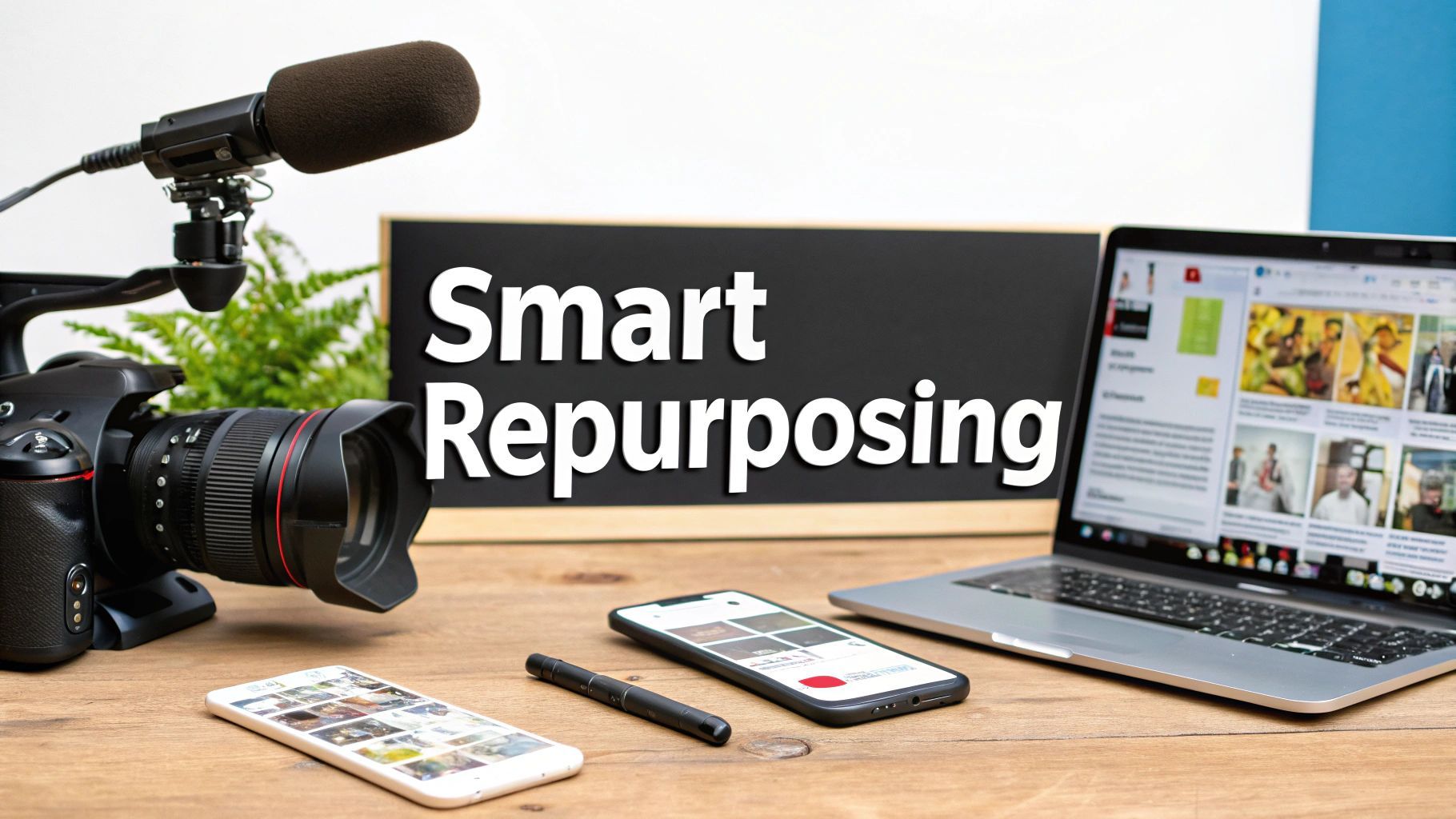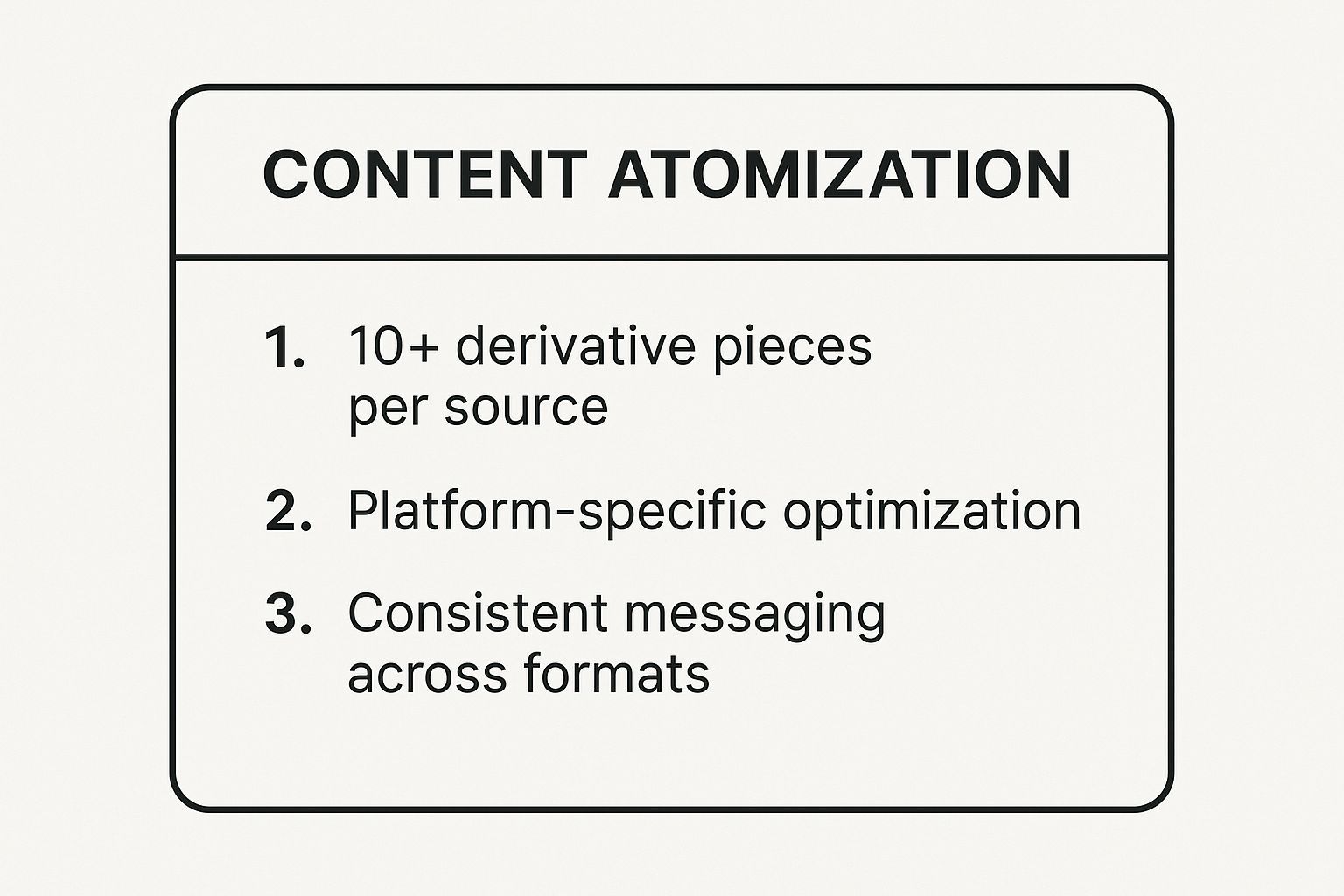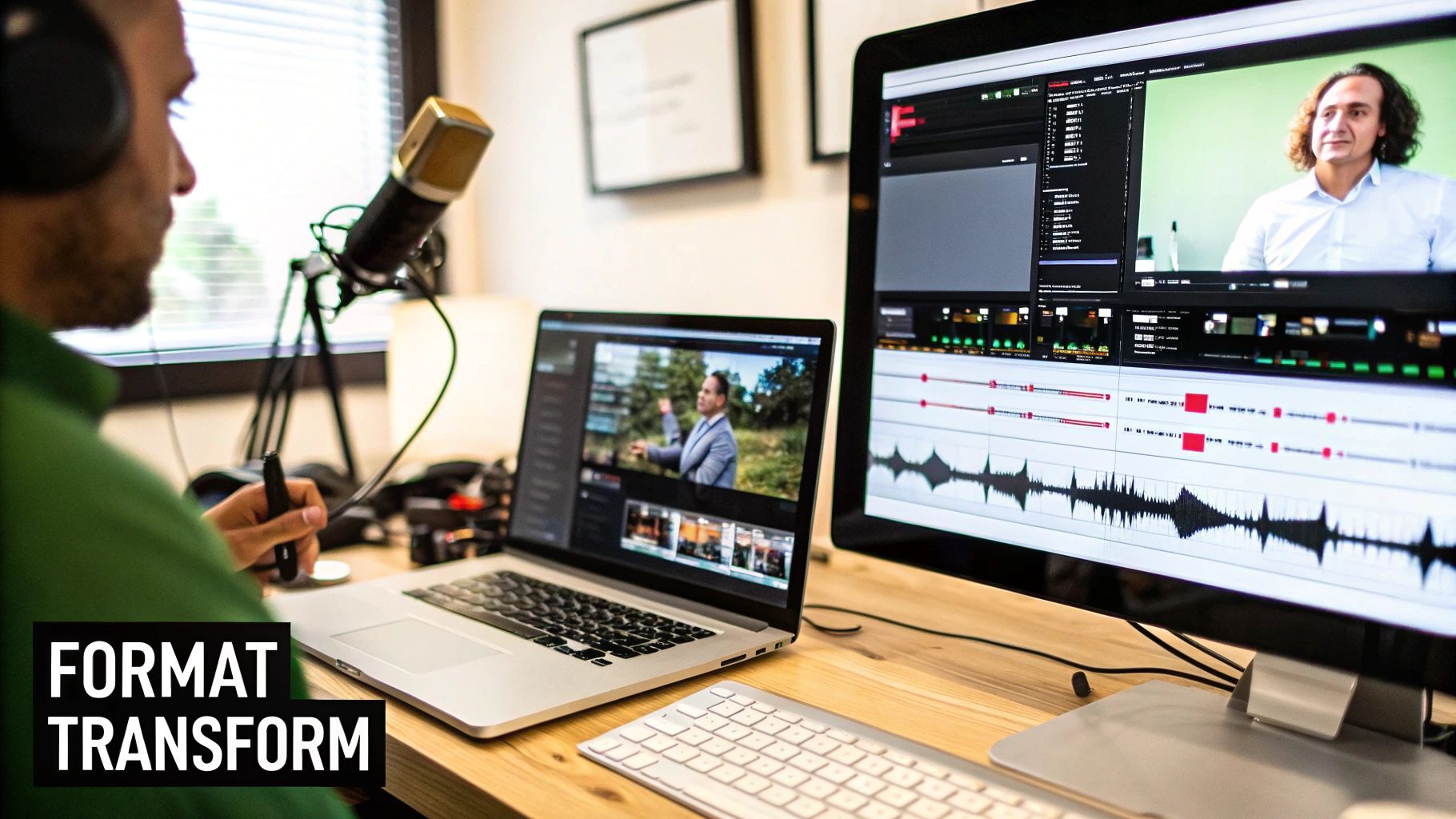How to Create AI Music That Sounds Incredible




Unlock your content's full potential with these 9 powerful content repurposing strategies. Learn to transform blogs, videos, and audio for maximum reach.
Are you stuck on a relentless content treadmill, churning out brand-new material every single day just to keep up? It’s exhausting, and frankly, it's an inefficient way to grow. The secret weapon of top-tier marketers and influencers isn't a magical fountain of endless ideas; it’s the art of intelligent transformation. This is where you stop creating more and start making your existing content work harder for you.
This guide is your off-ramp from the content creation hamster wheel. We're diving deep into nine powerful content repurposing strategies designed to multiply your output, amplify your reach, and reclaim your precious time. Forget the generic advice. We'll explore actionable frameworks that turn one solid piece of content, like a video or blog post, into a marketing arsenal. For an even deeper dive into various approaches to maximizing your content's lifespan, explore additional insights on effective content repurposing strategies.
From atomizing long-form articles into viral social snippets to leveraging AI tools like SendFame to create stunning new assets in seconds, you're about to discover how to make every piece of content you create pull ten times its own weight. Let’s get started.
Think of your best, most epic piece of content as a giant, delicious pizza. You wouldn't try to swallow it whole, right? Atomization is the art of slicing that masterpiece into perfect, bite-sized portions for everyone to enjoy. This is one of the most powerful content repurposing strategies because it takes a single, high-effort asset and multiplies its reach exponentially.
Popularized by content kings like Gary Vaynerchuk, who famously turns one keynote speech into dozens of content "atoms," this method is all about maximizing value. You take a comprehensive blog post, a detailed webinar, or an in-depth podcast and break it down into smaller, platform-specific pieces. That 2,000-word article becomes a Twitter thread, a carousel on Instagram, a series of TikTok videos, and a handful of quote graphics for Pinterest.
The goal isn't just to chop up your content randomly; it's a strategic dissection. Before you start, identify the 3-5 most potent takeaways from your original piece. These become the core messages for your new, smaller assets.
For a Webinar: Extract key soundbites for audiograms, turn compelling data points into an infographic, and use powerful quotes for LinkedIn text posts. For a Blog Post: Transform subheadings into individual social media posts, convert a numbered list into a quick-tip video, and pull a key statistic for a tweet.
Pro Tip: Create a simple content atomization template. List your core content piece at the top and create a checklist of potential "atoms" underneath (e.g., 5 tweets, 3 quote cards, 1 Instagram Reel, 1 email snippet). This ensures consistency and prevents great ideas from getting lost.
The infographic below highlights the core principles of effective content atomization for a quick reference.

As the visualization shows, the magic lies in producing a high volume of derivative assets while tailoring each one to its specific platform and maintaining a unified brand message.
If atomization is slicing a pizza, then cross-platform format transformation is like turning that same pizza dough into a calzone, stromboli, and garlic knots. You're using the same core ingredients (your valuable content) but reshaping it entirely to fit different tastes and occasions. This is one of the most effective content repurposing strategies for reaching entirely new audience segments who prefer different ways of consuming information.
This method involves taking a successful piece of content and completely changing its format. A popular blog post becomes a compelling podcast episode, a data-heavy report transforms into a vibrant infographic, or a video tutorial is transcribed and expanded into a detailed written guide. This isn't just a simple copy-paste; it's a true adaptation that honors the strengths of each new medium, as mastered by experts like Neil Patel and Michelle Schroeder-Gardner.

The key is to maintain the core message while tailoring the delivery. A podcast requires a conversational tone, while an infographic demands visual storytelling and minimal text. Start by identifying your highest-performing content and then brainstorm which new formats would best serve its core ideas.
Blog Post to Video: Use the post's outline as a script for a YouTube video. You can easily create professional-looking videos with an AI video generator. Video to Blog Post: Transcribe your video content and enrich it with more detail, screenshots, and embedded links to create a comprehensive article. Data/Statistics to Infographic: Pull the most compelling numbers and facts from a report or article and visualize them using a tool like Canva or Visme.
Pro Tip: Create a "format style guide" for your brand. Define how your core messaging, colors, and tone should be adapted for video, audio, and text. This ensures brand consistency no matter where your audience finds you.
Check out this video for a deeper dive into transforming your existing content into engaging video formats.
By transforming your content across platforms, you're not just reusing it; you're giving it a new life and an opportunity to connect with people in the way they prefer.
Ever notice how your favorite TV shows get a "reboot" or a "special edition" years later? Temporal content recycling is the marketing equivalent of that brilliant move. You take your "greatest hits" content from the past and give it a modern-day makeover, capitalizing on its proven success while making it relevant for today's audience. This is one of the smartest content repurposing strategies because the hard work is already done; you just need to polish the gem.
Pioneered by content powerhouses like Buffer and CoSchedule, this method involves identifying high-performing evergreen articles and updating them for the current year. Think of that "Ultimate Guide to Instagram Hashtags for 2021." Instead of starting from scratch, you update the stats, swap out old examples for new ones, and republish it as the definitive guide for the current year. It’s efficient, effective, and breathes new life into content that has already proven its worth.
The key is to treat your old content like a classic car, not a fossil. You're restoring it to its former glory with modern enhancements. Before you hit "republish," focus on substantial updates that add real value, not just changing the date in the title.
For a Statistics Post: Hunt down the latest data and reports to replace outdated numbers. Add a new section analyzing recent trends that weren't present in the original.For a "How-To" Guide: Update screenshots to reflect new user interfaces, replace broken links, and add new tools or techniques that have emerged since its first publication. Consider adding a quick summary video to enhance the user experience, and you can explore AI tools to help create them.
Pro Tip: Use your analytics to create a "Recycling Hit List." Identify the top 5-10 posts from the last 18-24 months that drove the most traffic but have started to decline. These are your prime candidates for a refresh. Set a calendar reminder every six months to review this list and schedule your updates.
Imagine you have the world’s best joke, but you tell it the exact same way to your grandma, your boss, and your five-year-old nephew. It probably won’t land with everyone. Audience-specific adaptation is the art of tailoring your core message to resonate deeply with different groups. This is one of the most sophisticated content repurposing strategies because it transforms one idea into multiple highly relevant assets.
This method, championed by industry giants like Salesforce and HubSpot, involves taking a single piece of content and reframing it for various audience segments. A guide on CRM best practices, for instance, is presented with different examples and pain points for a scrappy startup versus a multinational enterprise. The core information is the same, but the context, language, and examples change to speak directly to each group's unique world.

The goal is to make each segment feel like the content was created just for them. Before adapting, create detailed personas for each target audience to understand their specific goals, challenges, and language.
For Different Industries: A marketing guide for a B2B tech company will use different case studies and terminology than one for a local restaurant. For Different Skill Levels: Adapt a "Beginner's Guide to SEO" into an "Advanced SEO Tactics" piece by changing the depth and complexity, even if the core principles are related.
Pro Tip: Use dynamic content on your website or in your email campaigns to automatically show the right version of the content to the right person. This creates a hyper-personalized experience that boosts engagement and conversion rates.
As the image shows, the process involves taking a central idea and customizing its delivery for distinct groups. This ensures your message not only reaches more people but truly connects with them on their terms. This same principle can be applied when adapting written content into audio, which is where a powerful AI voice generator becomes a game-changer. Learn more about creating engaging, audience-specific audio content on SendFame.
Think of your favorite Netflix show. You don't just watch one episode and walk away; you get hooked and binge the whole season. This is the power of sequential content, a brilliant approach that turns standalone pieces into an interconnected series. This is one of the most effective content repurposing strategies for building an ecosystem that keeps your audience coming back for more.
Pioneered by content marketing legends like Brian Dean of Backlinko and the team at Moz, this strategy transforms isolated articles or videos into a cohesive journey. You take a broad, valuable topic and break it down into logical, sequential chapters. That one massive guide to SEO becomes a multi-part blog series, a week-long email course, or a playlist of step-by-step YouTube tutorials, creating an asset that builds momentum and deepens audience investment.
The secret is to think like a showrunner, not just a content creator. Plan the entire narrative arc before you release the first "episode" to ensure a coherent and compelling experience for your audience.
For a Blog: Take a comprehensive topic like "The Ultimate Guide to Content Marketing" and break it into a series: Part 1: Strategy & Planning, Part 2: Creation & Production, Part 3: Distribution & Promotion. For a Video Channel: Convert a long-form case study into a multi-episode series, with each video revealing the next step of the process. Backlinko excels at this with their detailed SEO case study breakdowns.
Pro Tip: End each piece with a compelling cliffhanger or a clear preview of what's coming next. Phrases like "In our next post, we'll reveal the one tool that doubled our conversions" create anticipation and encourage subscriptions so your audience won't miss out.
Once the series is complete, you can bundle all the pieces into a single, ultimate resource like a downloadable e-book or a comprehensive webpage. This final step repurposes the series itself into a powerful lead magnet or a cornerstone content asset.
Why do all the heavy lifting yourself? User-Generated Content (UGC) Integration is like hosting a potluck where your guests bring Michelin-star dishes. This strategy involves taking authentic content created by your customers, fans, and community members and weaving it into your own marketing tapestry. It’s one of the most powerful content repurposing strategies because it builds trust, fosters community, and generates a stream of genuine content without you lifting a finger.
Pioneered by brands like GoPro, which turned its customers into an adventure film crew, and Starbucks with its iconic #RedCupContest, this method transforms brand followers into brand advocates. You're not just repurposing your own content; you’re elevating your community's content, making them the heroes of your brand’s story. This turns passive consumers into active, engaged participants.
The key is to create a system that encourages participation while maintaining brand quality. To truly capitalize on this strategy, understanding the nuances of how to approach user-generated content marketing is crucial. For an in-depth look, consult a comprehensive guide to User Generated Content Marketing for best practices.
Launch a Campaign: Create a branded hashtag and a clear call-to-action that inspires creative submissions, like asking users to share how they use your product in a unique way. Curate and Credit: Select the best submissions that align with your brand's aesthetic and message. Always ask for permission and give prominent credit to the original creator.
Pro Tip: Set up a dedicated "Community Spotlight" segment on your blog, social media channels, or email newsletter. This gives users a specific goal to aim for, gamifies the submission process, and provides you with a consistent format for showcasing their amazing work.
Think of your existing content library as a garden. Some plants are thriving, others are wilting, and a few just need a little pruning to flourish. Data-driven refreshes are the gardening shears and watering can of content marketing, using analytics to turn good content into great, high-performing assets. It's less about creating something new and more about strategic renovation.
Pioneered by SEO experts like Brian Dean and the Ahrefs content team, this method focuses on identifying your "almost famous" content, the pieces that are performing but haven't reached their full potential. You use data to find articles ranking on page two of Google, see what's missing, and add new information, statistics, or media to push them to the top. This is one of the smartest content repurposing strategies because it targets assets that have already proven their value.
The key is to let data guide your decisions, not guesswork. Dive into your analytics to find content with high traffic but low conversion, or articles that are just shy of ranking for valuable keywords. Your goal is to give these pieces the final push they need.
For an Old Blog Post: Use Google Search Console to find keywords it's ranking for on page 2. Add a new section targeting those keywords, update outdated statistics, and embed a relevant new video or infographic. For an E-commerce Guide: Review performance data. If a guide on "Shopify for Beginners" is popular, refresh it with the latest platform features, new app recommendations, and updated screenshots to enhance its authority and user value.
Pro Tip: Set a quarterly "content audit" reminder. During this audit, specifically look for content that has lost traffic over the last 90 days. These are prime candidates for a data-driven refresh, as a simple update can often reverse the decline and reclaim lost rankings.
Imagine your content library as a sprawling city. Right now, it might be a chaotic collection of disconnected streets. Content clustering is like building a grand central station, creating a master plan that connects all your related content into an authoritative, easy-to-navigate hub. This is one of the more advanced content repurposing strategies because it transforms scattered assets into an organized knowledge empire.
Pioneered by marketing powerhouses like HubSpot, this method involves organizing existing content pieces around a central "pillar" topic. You take all those disparate blog posts, videos, and guides on a similar subject and link them together, creating a comprehensive resource that establishes your brand as the go-to expert. It’s not just about creating new content; it’s about giving your old content a new, powerful context.
The goal is to create a one-stop shop for your audience on a specific topic. Start by identifying your strongest areas of expertise and use them as the foundation for your pillar pages. This strategy signals to both users and search engines that you have deep knowledge in a particular area.
For a Marketing Agency: Gather all your articles on "lead generation," "social media ads," and "email marketing." Create a central "Digital Marketing 101" hub page that links out to each of these more specific cluster topics. For a Fitness Influencer: Take your individual workout videos, nutrition guides, and mindset posts. Organize them under a "Complete Guide to a Healthy Lifestyle" pillar page, with clear navigation to each sub-topic.
Pro Tip: Use keyword research to identify your core pillar topics and related cluster opportunities. Tools like Ahrefs or Semrush can reveal what questions your audience is asking, helping you structure your hub logically and fill any content gaps by repurposing existing materials.
This approach not only enhances user experience by making information easy to find but also significantly boosts your SEO. By interlinking related content, you create a powerful web of authority that search engines love.
Why let your audience just read when they could play? This strategy is all about turning passive consumption into an active, engaging experience. Interactive content transformation takes your static blog posts, guides, or data reports and morphs them into quizzes, polls, calculators, or assessments. It’s one of the most effective content repurposing strategies for boosting engagement and capturing valuable user data.
Pioneered by engagement masters like BuzzFeed with their viral quizzes and marketing powerhouses like HubSpot with their Website Grader, this method turns your content into a useful tool or a fun distraction. You’re not just telling your audience how to write better headlines; you’re giving them a Headline Analyzer tool (like CoSchedule did) to do it for them. This shift from information to utility is a game-changer.
The key is to find the "interactive potential" within your existing assets. Look for content built on data, decision-making processes, or personality traits, as these are ripe for transformation. For those looking to dive deep, learning how to create an interactive website can provide the foundational skills for these projects.
For a "Types of..." Blog Post: Turn it into a "What Type Are You?" quiz. A post on different marketing styles becomes a quiz that assigns users a marketer persona. For a Data-Heavy Report: Create an interactive calculator that lets users input their own data to see how they stack up against the industry benchmarks you presented.
Pro Tip: Start small. Before building a complex tool, test the waters with simple Instagram Story polls or Twitter quizzes based on your content. This gauges audience interest and helps you refine your interactive concept without a heavy initial investment. Don't forget to include clear calls-to-action within the experience to guide users on their next steps. If your interactive content needs visual elements, you can even use an AI image generator to quickly create custom graphics.
| Strategy | Implementation Complexity 🔄 | Resource Requirements ⚡ | Expected Outcomes 📊 | Ideal Use Cases 💡 | Key Advantages ⭐ |
|---|---|---|---|---|---|
| Long-Form to Short-Form Atomization | Medium-High: Template setup, organization needed | Moderate-High: Content creation + platform optimization | Increased content volume and SEO impact | Scaling content output from one source | Maximizes ROI, platform-specific optimization |
| Cross-Platform Format Transformation | Medium-High: Expertise in multiple formats required | High: Professional production tools and skills | Broader reach, multi-format engagement | Reaching diverse audience preferences | Format diversity, multi-sensory content |
| Temporal Content Recycling | Low-Medium: Regular audits and updates | Low-Moderate: Content review and refresh | Extended content lifespan, SEO freshness | Reviving high-performing evergreen content | Saves resources, boosts SEO with updated info |
| Audience-Specific Content Adaptation | High: Deep audience research, multiple versions | High: Customization per segment | Higher engagement and conversion | Targeted marketing for segmented audiences | Increased relevance, improved conversion |
| Series and Sequential Content Strategy | Medium-High: Planning and consistent publishing | Moderate: Coordinated content creation | Increased retention, deeper audience investment | Building content ecosystems and courses | Builds authority, sustained engagement |
| User-Generated Content Integration | Medium: Community management and curation | Low-Moderate: Monitoring and moderation | Enhanced authenticity and community engagement | Brands leveraging customer content | Reduced content costs, social proof amplifier |
| Data-Driven Content Updates | Medium: Analytics setup and data interpretation | Moderate: Research, SEO tools | Improved rankings, optimized existing content | Enhancing already-ranked or popular content | Maximizes ROI on existing assets, data-driven |
| Content Clustering and Hub Creation | High: Extensive planning and content volume needed | High: Content creation and ongoing maintenance | Strong topical authority and improved SEO | Organizing thematic content at scale | Boosts SEO, establishes thought leadership |
| Interactive Content Transformation | High: Technical development and maintenance | High: Web dev skills or platforms, longer timelines | Higher engagement, lead generation, social sharing | Engaging audiences with dynamic, participatory experiences | Active engagement, data collection, lead gen |
And there you have it, the ultimate playbook for transforming your content from a one-hit wonder into a timeless symphony. We've journeyed through nine powerhouse content repurposing strategies, moving far beyond the simple "turn a blog post into a tweet" advice. You're now armed with the blueprints to atomize long-form epics into a shower of social media gold, transform static data into interactive experiences, and build content hubs that establish you as an undeniable authority in your niche.
The biggest mistake you can make now is getting overwhelmed by the possibilities. The goal isn't to implement all nine strategies by next Tuesday. The real magic happens when you choose just one or two that resonate with your current workflow and audience needs. Is your podcast your crown jewel? Start with Long-Form to Short-Form Atomization. Got a treasure trove of killer data? Dive into Data-Driven Content Updates or create a stunning infographic.
Think of this not as adding more tasks to your to-do list, but as building a smarter system. The core principle behind every one of these content repurposing strategies is maximizing your return on effort. You've already done the hard work, the research, the creation. Now it's time to let that single piece of content work for you, again and again, in different formats, on different platforms, for different segments of your audience. This is how you escape the content treadmill and start building a self-sustaining content ecosystem.
Remember, the goal is to build an empire, not just a series of disconnected posts. Each repurposed asset becomes another entry point for your audience, another pillar supporting your brand, and another chance to capture attention in a noisy digital world.
Key Takeaway: Stop creating content. Start building a content engine. Each piece you create is a potential fuel source that can power dozens of other assets, driving reach, engagement, and authority long after its initial publication.
Your next step is simple:
Review your best-performing content from the last six months. Pick one piece that has untapped potential. Choose one strategy from this list and apply it.
Whether you're turning a webinar into a sequential email course or clustering old blog posts into a new pillar page, the key is to take action. Start building those connections, multiplying your impact, and watch as your content empire begins to take shape. Your audience, and your analytics, will thank you for it.
Ready to turbocharge your content repurposing with the power of AI? SendFame can help you instantly transform your long-form videos and audio into dozens of ready-to-publish social media clips, complete with branded captions and tailored formats. Stop spending hours editing and start multiplying your content's reach by visiting SendFame to see how our AI can build your content engine for you.
Create Epic
SendFame